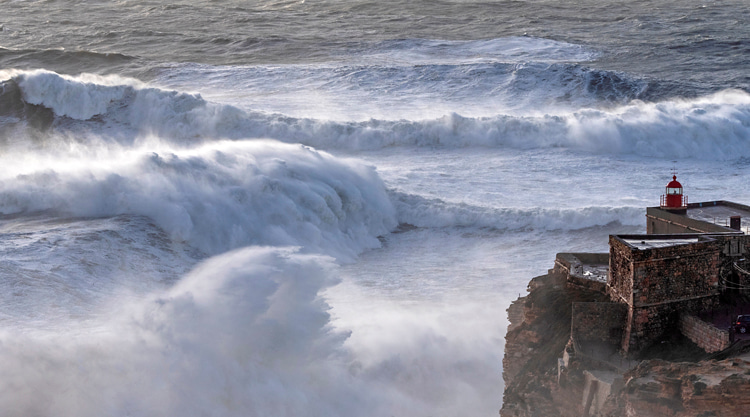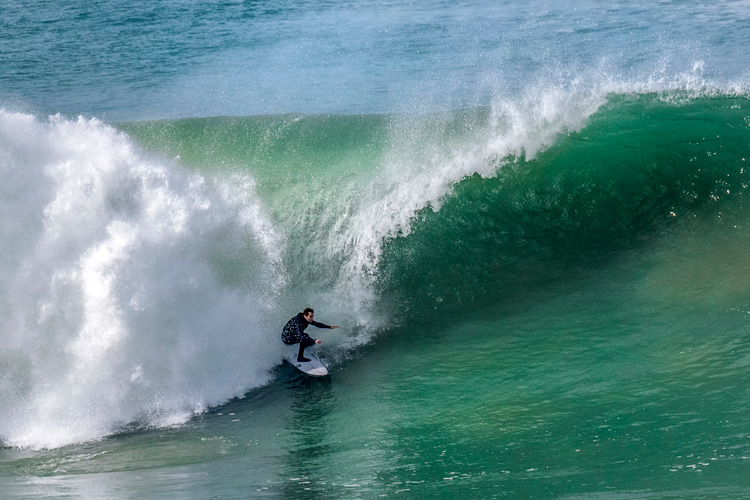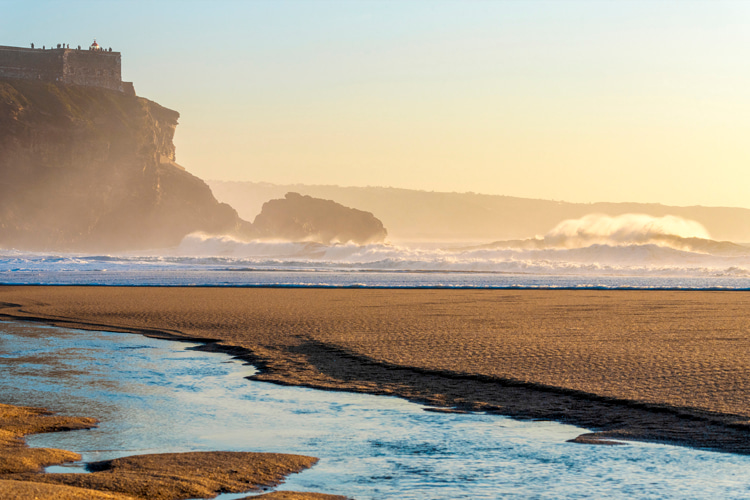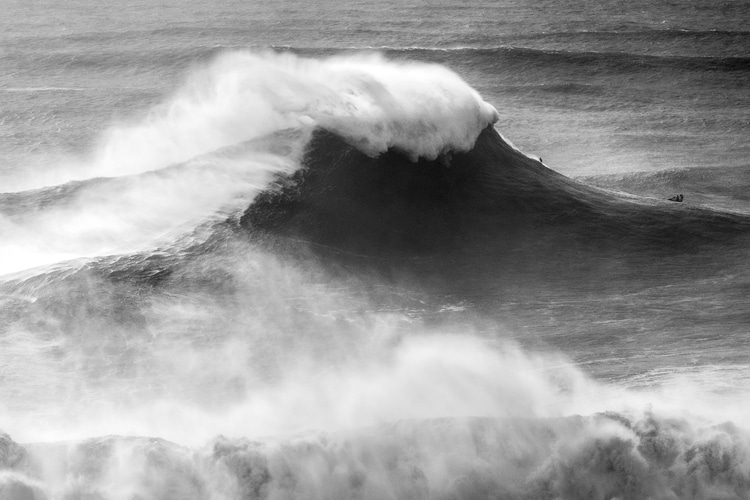Nazaré used to be a quiet Portuguese fishing town where residents were taught to stay away from the water due to its dangerous beach break.
The waves were considered impossible to surf, particularly during winter, until Garrett McNamara set a world record in 2011 for the largest wave ever surfed.
Nazaré became known all over the world, and people became aware of the waves' potential.
Since then, numerous surfing records have been set in Praia do Norte, including the Guinness World Record for the largest wave ever ridden - 80 feet (24.38 meters) - by Rodrigo Koxa in 2018.
Large swells usually slow down when approaching a coast due to interaction with the ocean bottom.
However, the impending swells offshore Nazaré do not lose energy until they reach closer to shore due to the 230-kilometer long and 5,000-meter deep, east-west oriented, underwater Nazaré Canyon.
The deep canyon maintains the wave energy and forward speed, funneling and magnifying the swells into enormous waves and abruptly hitting the much shallower headwall, breaking onto Praia do Norte, the Nazaré's northern beach.
The biggest waves are a product of two swells - one swell approaching from the canyon and one sideways from the shallower continental shelf.
They converge and result in constructive interference and a new increase in wave height.
Tidal conditions also help increase the height of the waves.
The big waves combined with their regularity have made Nazaré a hotspot for big wave surfing.

Big Wave Surfing's Hotspot
Every year more and more attempt to challenge the biggest wave in the world, and around 20 professional surfers stay in Nazaré during wintertime.
"There is nothing compared to this place. It is the most consistent place for big waves," says big wave surfer Freddy Olander.
"It's the scariest and the most challenging. It's the biggest you can get. You can get the biggest paddle waves of your life and the biggest tow-in of your life. It's crazy."
He plans to settle in Nazaré for the 2020/2021 winter season.
It is November 2019, and I am meeting Freddy Olander for the first time at Alex Wippel's place.
Alex, an Austrian big wave surfer, has a jet ski for sale, which Freddy considers buying.
"I actually never planned to tow surf. It has always been paddling to me, and I originally came to Nazaré to paddle without a rescue."
Freddy tells me how a scary experience from the last big paddle session changed his mind.
"I was out in the water with Eduardo Garcia [surfer and CEO of ORG surfboards] when this big cleanup set came, and a big wave smashed us both," explains Olander.
"I dived under, but the leash opened, and the wave took my board. I was so angry! So I was sitting there, with my impact vest, without my board when another big wave came."
The white water smashed around Freddy, terrifying him.
"I was thinking, 'Oh! My! God! I hope that I will survive.'"
Freddy laughs and recalls how he dived down again and, after a while, pulled the life vest.
"I came up very fast and realized, 'Oh, my God, I'm still in this f-----g impact zone!"
He did not have the board. The beach was far away. The lineup was far away. Freddy realized he was in the worst zone where the huge waves were breaking.
A jet ski driver came, looked at him, but picked up another guy and left before the next set of waves came.
"I was so panicked. I was shouting, 'Woa! Help! Help!'"
Marco Medeiros, another jet ski driver, picked up Eduardo.
"I was screaming at them. They came over, and both of them were screaming, 'Hey! Come! Come!' and really took me on the sled," recalls Freddy.
"We went out really fast and jumped over the waves, and I was thinking, 'Oh! My! God!' and realized, 'I need safety!" Freddy laughs out loud.
"If someone told me I would tow-in surf with a jet ski one day, I would say, 'You're f-----g crazy! Jet skis are the worst thing ever! It's loud, oily, petrol smelling,'" Freddy laughs.
"'Never ever! It's so against surfing!' But after a while in Nazaré, I realized I needed the whole package."

Unpredictable Behavior
All big waves are dangerous, but Praia do Norte is one of the most challenging places in the world to predict what will happen, as conditions can change in an instant.
"You know, you sit in the lineup, and the waves can be everywhere and coming from every side. It's so risky. You are always in danger. You always have to look," Freddy underlines.
At other big wave venues, the waves break in the same place with a recognizable, safe zone and impact zone.
In Nazaré, the waves are unpredictable.
The waves are so powerful and fast-moving that anything can happen, and even the most experienced Nazaré surfers can't predict what monster waves will jump out of the canyon next.
This means paddling to catch waves and navigating around the surf is impossible on big days and far too dangerous.
Freddy is well aware that it can be hazardous to be out in the water without rescue and someone who can get you out of dangerous situations.
At one point, the waves get too big for paddling.
There is just too much water moving, and more speed is needed to catch the waves.
"So, yeah, I guess I will be tow surfing as well. But my goal is to paddle the biggest wave. Not to get towed into the biggest one. Tow-in would be more of an achievement than a goal," states the German.
I ask Freddy about his very first time surfing Nazaré.
He tells me that due to his lack of experience surfing Praia do Norte, he decided to paddle from the southern beach.
When arriving at Praia do Norte, a jet ski driver kindly picked him up and put him into the lineup.
"But the current and water was moving crazy fast, and I had no chance to stand in the lineup," he says.
The current was too strong to paddle against, and it kept bringing him closer to the lighthouse and cliffs.
"I thought, 'OK, I don't want to catch my first wave and end up in the cave.' So I gave up and paddled all the way back to the southern beach."
You have to be kind of crazy to paddle out on a really big day. I wonder if Freddy is not afraid.
"When I see crazy big walls, I'm thinking, 'Oh my God, I'm so happy!' But there are some sizes where you get scared, you know," adds the Berliner.
We are talking about different types of waves, and I ask what his favorite part of surfing is.
"Handling big drops! I love big, heavy drops, critical zones of drops, riding down the line, and just feeling Nature! To speak with Nature and be one with Nature."
"You know, when you ride down these big walls with the hand touching the water, and you look up and, 'swoosh,'' you hear the sounds."
"It's a crazy good feeling! And if you realize you will not make it, you just... pee in your pants," Olander says.
After listening to scary wipeout stories from around the world, I ask if he gets more cautious after experiences like that.
"This is a crazy point. I mean, then I want more!"

Extreme Surf Addiction
When talking with Freddy at the end of the 2019/2019 winter season, we are not aware that the coronavirus will affect the way we live.
Back then, he told me that surfing is like a drug addiction and that he wants to surf all the time, and the only thing that makes him depressed is if he gets injured and can't surf.
"That's the worst, you know, or if I am too long away from the coast," reveals the big wave surfer.
In early July, I call him to check on him and how the Covid-19 and quarantine situation has affected him and his life.
He was planning to go to Mozambique or Namibia and Mexico this summer, but apparently, the new situation means he's stuck in Berlin.
"If I stay too long away from surfing, I get depressed, rude, and aggressive," Freddy says, laughing.
"So I am not in such a good mood anymore. I miss surfing a lot, but maybe it's good in a way."
"We might realize more how much we miss the ocean and surf and appreciate it more when we are able to travel and be traveling again."
"Now traveling starts again, so it's all good. It's kind of luxury problems, really."
Freddy is right. Many things we previously have taken for granted will now, hopefully, be more appreciated.
Let's hope the situation will change for the better and that we will both be back in Nazaré when the huge swells start rolling for the 2020/2021 winter season.
Keep your eyes open on this rising star.
Freddy Olander is going to be one to watch in the next few years. And to all the sponsors out there, he is looking for you right now.
Words and Photos by Heidi Hansen | Writer and Geologist
